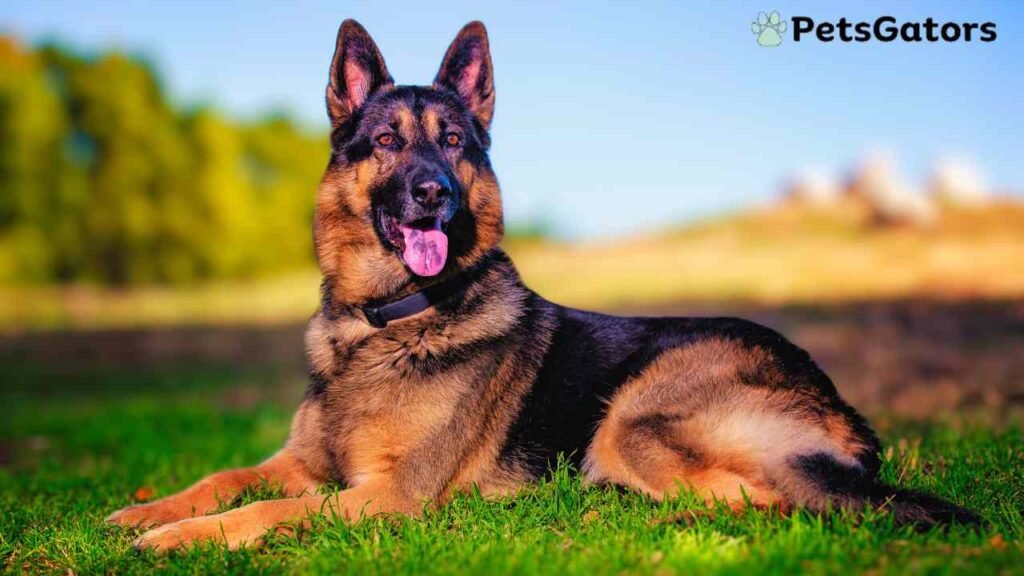Introduction
It’s awesome to have a Red German Shepherd puppy that provides satisfaction of value, intelligence, and a unique quality among them. These wonderful dogs have the same famous characteristics as the German Shepherd, but in addition to that, they are known for their beautiful coat that comes in a variety of red colors. Nevertheless, to give your Red German Shepherd a real chance in life, you need to familiarise yourself extensively with his dietary and healthcare needs.
In this book, you will find tips that will help you to train your pet by using the body and mind of the pet to their maximum potential and the care guidelines you have to follow when they down the line. Through the use of these approaches, you are striving to develop a deep and sustained friendship with your animal partner, which will guarantee their life, health, and liveliness up to the age of the elderly.
Overview of Red German Shepherd
| Aspect | Details |
| Breed Name | Red German Shepherd |
| Origin | Germany, late 19th century |
| Coat Color | Various shades of red, including mahogany |
| Size | Medium to large; typically 22-26 inches in height at the shoulder |
| Weight | 50-90 lbs (22-41 kg) |
| Temperament | Confident, intelligent, loyal, and protective |
| Training | Positive reinforcement, consistency, short and frequent sessions |
| Exercise Needs | High; requires daily physical activity and mental stimulation |
| Common Health Issues | Hip dysplasia, elbow dysplasia, degenerative myelopathy, bloat, food allergies |
| Lifespan | 9-13 years |
| Key Traits | Strong, muscular, agile, alert; excellent work ethic and trainability |
| Ideal For | Active families, individuals who enjoy training and outdoor activities |
| Care Requirements | Regular vet check-ups, balanced diet, proper exercise, and grooming |
The Fascinating History of the Red German Shepherd
In 19th Century GermanyOne of the dogs, Red German Shepherd is derived from a genealogy that marks the late 19th century in Germany.
These unique dogs are the result of many different breeds of herding animals, all of which are designed to be effective dog workers. The red coat color is rarer which is why it became even more fascinating to the many that loved the traditional black and tan.
First Public Showcase
The year 1882 saw a defining moment when the German Shepherd breed was first publicly presented in Hanover, Germany.
This landmark brought the dogs to the public eye for the first time, showing off their beautiful appearance and the wonderful abilities they had as working dogs. This remarkable event opened the breed to other enthusiasts and the future popularity of the breed was inevitable.
Max von Stephanitz and the Quest for Standardization
The German Shepherd we know today is greatly the result of Max von Stephanitz, an imaginative individual who recognized the potential in these dogs. As a leader in the German army, he played a critical part in the establishment of the breed’s standards.
The 1920s was the period during which, as a result of his efforts, not only the strikingly red-coated animals but also the whole German Shepherd breed began to be characterized by a characteristic appearance and temperament.
The work he did back then provided them with the reputation of being loyal, intelligent, and versatile, which are the very qualities that have kept the Red German Shepherds the most favorite pets in homes and also helped them to become the best working dogs of the recent age.
Training Your Red German Shepherd
One principle that has worked well for those who have trained red color dogs is to train using positive reinforcement. Praise, treats, and affection are all crucial to them in a way that they can learn new behaviors only through these methods.
By helping your dog develop such habits, you not only achieve good behavior, but the relationship between both of you also grows naturally. Besides, German Shepherds are easily obedient and love to please, so it’s a very good method!
Consistency is Crucial
Effective training means that practice has to be in a consistent manner. From the start, make sure you set out the rule that applies to all members of the family and do not bend these rules. A scheduled training session with your dog will help you a lot whether the dog is a small puppy or a large adult.
Short but frequent training sessions are generally more effective than long, irregular practices. Through this method of training, your Red German Shepherd will catch on to your expectations, and from that point with proper basic training., it will be pretty easy to apply the training to more advanced obedience.
A Natural Talent for Obedience
It is common knowledge that red German Shepherds are the best when it comes to obedience. Owning to their intellect and work ethic, they can be taught to do more complex duties. Just begin by giving them simple commands like “sit,” “stay,” and “come,” and then gradually add more complex assignments.
It is very positive to sign and speak as this sort of support reinforces their understanding. To lose them, present them with new and more difficult tasks as they can complete each task whilst at the same time their attention is aroused and they are actively involved.
Appearance and Temperament
The Red German Shepherd is easily noticed at first sight due to their unique quality. The mahogany, warm, shiny coat, their upright ears, and their alert eyes express the intelligence and sharpmindedness that one wouldn’t expect.
With the ideal physical appearance, which is strong and muscular, they embody every standard that considers the breed agile and vigorous.
Read Previous – Miniature French Bulldog
A Confident and Loyal Personality
A dog owner making a Red German Shepherd part of the family will, on one hand, observe his dog as a confident and intellectual friend.
Their loyalty is so deep that it is common for these animals to form strong closeness with their family members.
Their fierce loyalty combined with their protective nature certainly makes them good guard dogs. However, it is their socialization that still counts the most for them to be well-balanced.
Work Ethic and Trainability
The fact that red German Shepherds are used up in search and rescue dog sports and competently handle shepherd activities is evidence of their intelligence, obedience, and eagerness to please which sets them apart from other titles.
Whether in traditional herding roles or the modern environment, dogs are known for their various capabilities. Their French agility that is coupled with the intense determination that they have makes them unique in their areas of specialization such as search and rescue missions and dog sports.
Health Considerations for Red German Shepherds
As with all German Shepherds, the Red German Shepherds are prone to health problems as well. One of the most common of these is hip dysplasia, a genetic mutation that affects about 21% of the breed.
This is a genetic disorder where hip joint development is abnormal and this may, in turn, lead to joint pain and lameness. This can be managed effectively through proper exercise and diet.
Other Potential Concerns
Of course, apart from hip dysplasia, you might have a Red German Shepherd that comes across elbow dysplasia on top of that.
Or maybe yours will have degenerative myelopathy, which is a nerve disease progressively impairing canines’ mobility. On the other hand, bloat and food allergies could also occur due to the lack of enzymes that are important in stomach digestion.
Common symptoms that take place as a result of bloat or food allergies include skin irritations or digestive tract problems. Being well-informed about these symptoms can lead to early diagnosis and proper care of your pet.
Preventive Healthcare and Check-Ups
Maintaining top-notch health for your Red German Shepherd involves routine vet visits. A timely diagnosis of common health problems can lead to effective treatments and improved lifespan. Combine this with a balanced diet, good exercise habits, and regular genetic testing to reduce health risks.
Finding a Responsible Breeder
Before you buy them, perform extensive research on potential breeders, especially inquiring about their breeding practices.
The breeders who have good records and also positive comments from previous clients are the best ones for you. Get a list of references, and send them emails.
A reliable breeder should be straightforward with you when it comes to their puppies’ background health and the methods they use to breed them and should include genetic testing and health clearances of other dogs.
The Screening Process
Serious breeders take responsibility for finding proper homes for their puppies that are loving and compatible.
Expect an extensive assessment process of the breeder to include items such as asking the future owners about their preferences, their dog-related experience, their plans for the development of the puppy, etc.
This way of operating emphasizes the breeder’s dedication to the protection of dogs as being more important than their job of selling puppies.
Visiting the Breeder’s Facility
Check with the breeder to schedule a visit to their site. This trip gives you the chance to check if the place is clean and to assess the puppies’ health and temperament by watching how they interact with each other and the parent dogs.
The well-informed breeder will gladly welcome your visit because it is an opportune moment to enlighten you about the breed. Be mindful of how the puppies play with each other and their owner with regard to their health or behavioral clues. Healthy puppies are playful and inquisitive, unlike sick or sad puppies, which is not a good sign.
Wrapping Up Your Journey
As you set out on your quest with a Red German Shepherd, you should be aware that proper training and medical care are the main keys to having a happy, well-behaved friend.
By sticking to consistent training, providing early socialization, and prioritizing regular vet visits, you’ll establish a solid foundation for conductive communication with your loyal friend.
Besides, you have to learn how to avoid breed-specific health issues and feel free to consult vets/dog trainers if necessary.
Affection and devotion are what will ultimately allow you to have a close bond with one of these awesome dogs for your and their lifetime. Value the specific attributes of this hoary breed and honor the attachment that you have with your defender.
Conclusion
When choosing to own a Red German Shepherd it is important to know that training and healthcare are two of the most important steps that you should take to ensure that your long-term friend is always healthy and in good form. Through the provision of quality and standardized training, socialization of the pet at a tender age, and regular check-ups from a qualified veterinarian you will be well set to harmoniously and effectively relate with your best friend.
Be ready for all the health problems proper to this breed and do not deny help from trainers and others when necessary. By so doing, you will be able to win the heart of your Red German Shepherd and hence have a good companionship for many years. Accept this outstanding version of the German Shepherd breed and appreciate your smart and loyal furry companion.
Stay connected and updated with – PetsGators.com!







